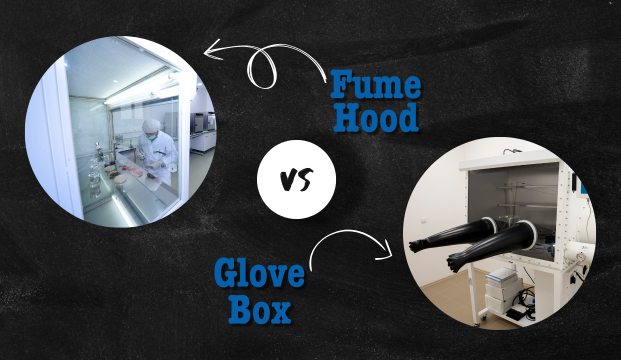In laboratory environments, two essential pieces of equipment play a vital role in ensuring safety and control: laboratory fume hoods and laboratory glove boxes. These specialized systems are designed to protect researchers, samples, and the environment from potential hazards. To make the right choice of equipment for your laboratory, it is vital to have a clear understanding of the purpose, functionality, and differences between laboratory fume hoods and glove boxes. This knowledge will help ensure that you select the equipment that best meets the specific needs of your laboratory.
Laboratory Fume Hoods
A laboratory fume hood is an enclosed workspace created to contain and exhaust hazardous fumes, vapors, or dust generated during various laboratory operations. Its primary purpose is to serve as a protective barrier, preventing researchers from inhaling potentially harmful substances and maintaining a safe working environment. Fume hoods operate by utilizing a ventilation system that creates controlled airflow. This airflow moves from the lab space into the fume hood, carrying any contaminants away from the researcher. If working with a ducted fume hood, the contaminated air is then expelled through a ducting system and safely discharged outside the building or treated accordingly. Fume hoods find extensive use in chemical handling, experimentation involving hazardous materials or reactions, and sample preparation processes.
Related: How Does a Ductless Fume Hood Work?
Laboratory Glove Boxes
A laboratory glove box, also known as an isolation glove box or containment chamber, is a sealed enclosure designed to provide a controlled atmosphere isolated from the external environment. It enables researchers to manipulate materials and perform experiments under controlled conditions, often involving the use of inert gases or specific controlled environments. Glove boxes feature an airlock system, typically comprising two sets of interlocked doors, which prevents ambient air from entering the enclosure when items are being transferred in or out. The glove box environment can be modified to maintain specific conditions such as temperature, humidity, or inert gas atmosphere, thanks to built-in controls and monitoring systems. They are commonly used for handling air-sensitive materials, containment of hazardous substances, and conducting biological research with sensitive samples.
Ventilation vs. Isolation
While laboratory fume hoods and laboratory glove boxes share common goals of containment and safety, there are notable differences between the two systems. Fume hoods primarily focus on containing and removing hazardous fumes, vapors, or dust, utilizing ventilation and exhaust systems. In contrast, glove boxes provide an isolated environment for handling air-sensitive or hazardous materials. They maintain a controlled gas environment, often filled with inert gases, protecting materials from exposure to the external atmosphere. Another difference lies in the method of material manipulation. Fume hoods allow direct manipulation with hands, while glove boxes require the use of gloves built into the system’s walls, ensuring a sealed environment. Additionally, glove boxes offer a higher level of protection by isolating materials from the external environment, safeguarding against contamination and exposure to air-sensitive substances.
Choosing the Right Equipment: Exploring the Differences Between Fume Hoods and Glove Boxes
When choosing between a laboratory fume hood and a laboratory glove box, several factors should be considered. Conduct a thorough hazard assessment to evaluate the risks associated with the materials you will be working with, ensuring that the chosen equipment provides adequate protection. Consider the specific experimental requirements, such as the need for an inert gas environment, air sensitivity, or containment needs. It is also essential to take into account available laboratory space and budget constraints, as both fume hoods and glove boxes require dedicated installation and ongoing maintenance.
Laboratory fume hoods and laboratory glove boxes serve distinct but complementary roles in laboratory safety and control. Fume hoods focus on removing hazardous fumes and ensuring a safe working environment, while glove boxes provide a controlled and isolated environment for handling air-sensitive or hazardous materials. By conducting a thorough hazard assessment, considering specific experimental requirements, and accounting for space and budget constraints, laboratories can make informed decisions to safeguard researchers, samples, and the surrounding environment. Additionally, regular maintenance and adherence to industry guidelines are crucial to ensure optimal performance and safety.
Whether you are working with volatile chemicals, air-sensitive materials, or biological samples, the selection of the right equipment—be it a laboratory fume hood or a laboratory glove box—plays a crucial role in maintaining a secure and productive laboratory environment.
Remember, safety should always be a top priority in any laboratory setting. By utilizing these specialized systems effectively, researchers can focus on their work with confidence, knowing that they are protected from potential hazards and that their experiments are conducted in controlled conditions conducive to accurate and reliable results.
Choose wisely, invest in proper training, and follow recommended protocols to create a laboratory environment that promotes safety, innovation, and scientific excellence.
If you need assistance in choosing the right equipment for your work area, please don’t hesitate to contact us. At Fisher American, we have a remarkable selection of casework, workstations, fume hoods, and related lab products. Most of our items can be shipped quickly. In most cases, less than two weeks.


